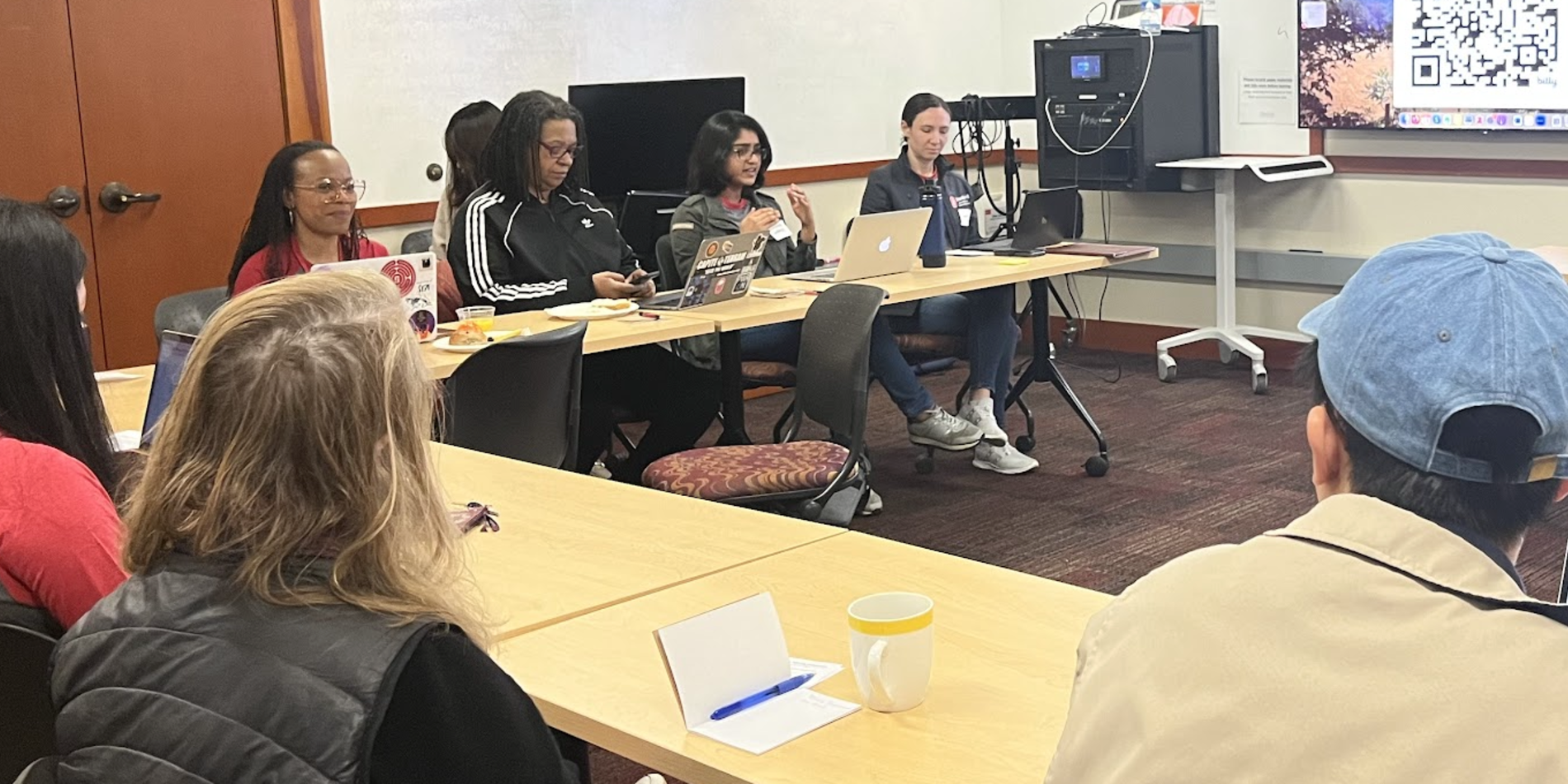Rhetoric from the Field: Mexican American Rhetoric Panel Launches Cultural Rhetorics Notation
This year’s launch of the Cultural Rhetorics Notation arrived with a formidable splash on Friday November 5, when PWR hosted the panel and discussion “Mexican American Rhetoric” as its inaugural Cultural Rhetorics event. The well-attended Zoom symposium brought together three major voices from the field of Mexican American Rhetoric, Professor Aja Martinez (University of North Texas), Professor Jaime Mejía (Texas State University), and Professor Gabriela Ríos (University of Colorado, Boulder), who offered a wide-ranging conversation exploring what Mejia described as the “extraordinarily complex” history of Mexican American rhetoric in the United States and the borderlands. These speakers and PWR moderators facilitated a vibrant conversation, attended by PWR lecturers and affiliates, Stanford students and colleagues, as well as colleagues from across the country.
The panel began with introductory remarks by PWR Faculty Director Adam Banks and Lecturer Gabrielle Moyer. Banks described the panel, as well as the mission of bringing the study of Cultural Rhetorics to Stanford as a project created to engender “rhetorical education that is big enough, capacious enough for all of us.” As Banks explained, “One of the goals of this notation is to help students understand that all uses of language that fall under the study of rhetoric are culturally situated.” Cultural rhetorics has the capacity to make us “better, more ethical, more thoughtful communicators,” and the study of rhetoric more broadly “can help us be a better society, and better to each other.” Dr. Moyer helped to kick-off the event with specific introductions for the three “radical and foundational” speakers.
Professor Mejía spoke first, in a talk titled “Crossing Over and Crossing Back, Over and Over Again,” an account of thinking about Mexican American rhetoric amid the challenging backdrop of the COVID-19 pandemic and the social and political moment of 2020. Like many academics, Mejía relocated amid pandemic closures, from San Marcos to his South Texas “home home” in the Rio Grande Valley, where he cared for his disabled father and reconnected to the community he grew up in. “I’d been away much too long, and it took a pandemic to bring me back,” Mejía reflected, commenting on the joys of watching classic telenovelas and Mexican movies while he served as his father’s caretaker and taught remotely.
The move also provided an opportunity to observe the changing politics of the Rio Grande Valley amid the “raised consciousness” of 2020 as a time of sweeping racial and political reckoning for the entire US. Especially vexing for Mejía was the media’s misportrayal of political culture in South Texas. Traditionally a Democratic stronghold for the Mexican American base, some news sources’ portrayed the region’s politics as an alliance in “decay”; Mejía cited the media’s conspicuous clumsiness with demonyms like “Tejano” and “Latinx.” A key problem, in Mejía’s eyes, lies in the contrast between the experience of Mexican people “crossing over” by necessity, and that of “white people who prefer not to cross over” to bear witness to and work to understand the experience of Mexican Americans. Yet the situation for Mexican Americans remains marked by internal contradictions as well: individuals, families, and communities in the Rio Grande Valley live in close proximity to a Mexico that is, for many of them, “no longer a homeland,” and also must navigate communities members who can sometimes work at “cross-purposes” to one another “because of the process of crossing over and assimilating.” Mejía suggested that spaces such as the traditional escuelitas (or “little schools”) of the region, which work to preserve Mexican culture in regions of oppression, offered a model for honoring and promoting Mexican American rhetoric. There is a profound need, Mejía argues, to build a “compendium” of Mexican American rhetorical strategies.
The panel’s second speaker, Professor Gabriella Ríos, demonstrated the work of creating this compendium directly in her talk titled “Testigos de Maíz: One South Texan Chicana’s Theory in the Flesh.” Ríos, who like Mejía also possesses South Texas roots, explored as well as practiced rhetorical strategy in the genre of the testimonial, a process she described as “family history mapped against theory.” For Rios, testimonial has special power as a genre with the “potential for bridging personal and public histories.” Growing up in Kingsville, Texas, south of Corpus Christi, Ríos was surrounded by “strong women who had lived hard,” and who taught her “to be tough, to laugh often, and never forget where [she] came from.” Ríos’ mother provided her with a strong sense of what it meant to be Indigenous; she disliked the terms “Latino” and “Hispanic” because they discarded Indigenous identity, and refused to sign field trip permission slips for Rios to visit monuments to Columbus’ ships. Later, Ríos would come to recognize the broader context and meaning of her mother’s resistance to racial taxonomies created by “progressive science,” as well as to structural processes of ethnocide, systemic repression, and de-Indiginization. Ríos presented her experience and the broader experience of Indigenous peoples in the context of 2020’s moment of racial reckoning in the US, asking the urgent question: what is the relationship between Blackness and Indigeneity? It was a point of special significance for Ríos that George Floyd attended her own alma mater Texas A&M University, Kingsville (or TAMUK) in the 1990s, years before his horrific murder at the hands of police in May 2020. These stories all lead intuitively, for Rios, back to cultural and rhetorical theory. As she put it, “I am invested in theory because I am invested in story,” a process that Professor Banks pointed out is, by definition, one of “world-building.”
Storytelling and the legacies of ancestral storytellers were also at the core of Professor Aja Martinez’s talk “Encomium of a Storyteller: Grampa Alejandro’s Mexican American Rhetoric.” This richly layered account—at once a powerful example of counterstory, a working theory of Mexican American rhetorics, and a moving tribute—narrates the experience of Martinez’s grandfather Alejandro Ayala Leyva, who lived nearly a century and whose stories were “intricately linked to major events in US history.” Martinez’s Leyva ancestors left Durango, Mexico in 1913, where they shared heritage with the Huichol people, who within the community refer to themselves as Wixáritari. In the US, Leyva and family members labored alongside Chinese migrants on the railroad, and in some cases even lived in boxcars. This hard work was unfairly and ironically betrayed when the family found themselves ensnared in the mass deportations of so-called “Mexican Repatriation” during the 1930s-40, when family members—including children born inside the US—were placed on a train bringing them to Mexico. It was only Leyva’s father’s (Professor Martinez’s great-grandfather) knowledge of birthright citizenship that gave him the courage to tell his family to get off at the last stop, in Nogales, Arizona. As Martinez summarized the meaning of her movingly delivered, transhistorical account, “These Mexican American rhetorics serve as counternarratives to the overarching master tropes that would describe us as ‘outsiders’ to be repatriated in my grampa’s generation, ‘Americanized’ in my parents’ generation, assimilated in my generation, and victimized yet defiant in the face of colonization in all generations.”
The panel was, in short, a wild success, modeling, as Martinez put it, “methodologies” that at once “get beyond Western frameworks” and also transcend “hierarchies within Latinidad.” It also strongly indicates the success of the forthcoming work of the Cultural Rhetorics Notation at Stanford, which promises, as Banks put it, to be a vibrant space “where rhetorical connections of commonplaces can be made,” indeed a home for the challenging but essential process of “connecting with people who want to build a world big enough for all of us” and a “society worth having.”
Reflecting more broadly on the notation and the event, Banks added, “The Notation in Cultural Rhetorics gives us a chance to help students see just how expansive rhetoric is as an area of study. Yes it’s strategic communication and ‘how can we be persuasive?’ but it's also the work that language, that discourse does in the world. It’s a crucial area of study to complement any student's major while they are here, and an interdisciplinary pursuit that can help students be effective as citizens and leaders in the lives they build after graduation.
“Mejía, Ríos and Martinez gave us a real gift in their talks because they were willing to share with us in a moment when they are beginning a project to chart out just what Mexican American Rhetoric might be and become. The fact that each of them focused heavily on story as a crucial site of knowledge making is also really exciting for the broader study of rhetoric and gives us inspiration for our own program's work through our classroom teaching and through our constituent programs the Stanford Storytelling Project, the Oral Communication Program and the Hume Center for Writing and Speaking.”
Professor Banks and Hume Center Director Dr. Zandra Jordan will co-teach PWR 194NCR: Introduction to Cultural Rhetorics for the first time in Winter Quarter 2022.



